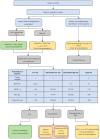New Drugs and Therapies in Pulmonary Arterial Hypertension
- PMID: 36982922
- PMCID: PMC10058689
- DOI: 10.3390/ijms24065850
New Drugs and Therapies in Pulmonary Arterial Hypertension
Abstract
Pulmonary arterial hypertension is a chronic, progressive disorder of the pulmonary vasculature with associated pulmonary and cardiac remodeling. PAH was a uniformly fatal disease until the late 1970s, but with the advent of targeted therapies, the life expectancy of patients with PAH has now considerably improved. Despite these advances, PAH inevitably remains a progressive disease with significant morbidity and mortality. Thus, there is still an unmet need for the development of new drugs and other interventional therapies for the treatment of PAH. One shortcoming of currently approved vasodilator therapies is that they do not target or reverse the underlying pathogenesis of the disease process itself. A large body of evidence has evolved in the past two decades clarifying the role of genetics, dysregulation of growth factors, inflammatory pathways, mitochondrial dysfunction, DNA damage, sex hormones, neurohormonal pathways, and iron deficiency in the pathogenesis of PAH. This review focuses on newer targets and drugs that modify these pathways as well as novel interventional therapies in PAH.
Keywords: new drug targets; novel therapies; novel treatments; pathogenesis; pulmonary arterial hypertension.
Conflict of interest statement
The authors declare no conflict of interest.
Figures


References
-
- Humbert M., Kovacs G., Hoeper M.M., Badagliacca R., Berger R.M.F., Brida M., Carlsen J., Coats A.J.S., Escribano-Subias P., Ferrari P., et al. 2022 ESC/ERS Guidelines for the diagnosis and treatment of pulmonary hypertension. Eur. Heart J. 2022;43:3618–3731. doi: 10.1093/eurheartj/ehac237. - DOI - PubMed
Publication types
MeSH terms
Substances
LinkOut - more resources
Full Text Sources
Medical
Miscellaneous

